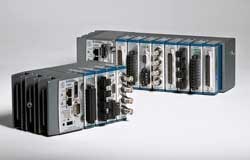
Posted to News on 15th Jul 2010, 15:48
PAC improves accuracy of rolling mill process control
I2S is using CompactRIO real-time programmable automation controllers from National Instruments to improve the performance of its steel rolling mills by increasing the accuracy of online thickness measurements.

Integrated Industrial Systems (I2S) has used programmable logic controllers (PLCs) for years to automate and control the steel rolling mills ghat it manufactures and refurbishes. To increase the efficiency and quality of the steel from the mills, the company has implemented a gamma gauging system to control the thickness of metal more accurately. The gamma gauging system has been a staple of the I2S product family for many years and continues to be a well received product, but many of the features, both hardware and software, have become outdated. To optimise the efficiency of its rolling mills, I2S needed a custom measurement device with accurate analogue I/O, together with advanced processing to convert the signal from the sensor into an accurate metal thickness.
Unfortunately the PLCs used to automate the rolling mills did not provide the high-speed analogue I/O and processing required. Instead, I2S has used National Instruments CompactRIO PAC (programmable automation controller) hardware within a custom measurement and analysis system developed specifically for this application. I2S is now now able to integrate multiple CompactRIO systems with existing PLC hardware to improve the quality and efficiency of rolling mills both quickly and easily.
The CompactRIO (compact, real-time I/O) PAC provided the reliability and ruggedness of a PLC for the harsh environment and critical nature of the control systems well as the necessary high-speed analogue I/O and signal processing capabilities. With NI LabVIEW graphical programming tools, and the built-in LabVIEW FPGA (field-programmable gate array) and LabVIEW Real-Time function blocks, I2S was able to program the FPGA and real-time processor in CompactRIO much more quickly than might have been expected.
Data processing
In the steel thickness measurement system, the CompactRIO analogue input modules are connected to gamma-based thickness sensors so the I/O rates and synchronisation can be customised with the CompactRIO embedded FPGA. The data received from the sensors is processed in the CompactRIO real-time processor using built-in NI LabVIEW Real-Time floating-point function blocks to convert the data from the sensors into an accurate thickness measurement. LabVIEW real-time performs deterministic, advanced logarithmic processing on the data received from the FPGA to calculate the thickness measurements.
The CompactRIO systems perform all of the I/O and signal processing in the FPGA and real-time processor, and transmit a high-accuracy thickness measurement to connected PLCs without slowing down the existing PLC control loop rates. With the performance of CompactRIO, I2S is able to add this custom measurement and analysis for its gamma-based sensors without compromising the control rate speed.
Each rolling mill contains three networked CompactRIO systems, all of which perform as intelligent nodes communicating with other controllers using industrial-standard Modbus/TCP, TCP/IP and UDP protocols. Two CompactRIO systems are connected to the gamma-based sensors and perform the analogue input measurements and the advanced processing to calculate the thickness. The third CompactRIO system takes the thickness measurements from the other two systems and performs an analogue output measurement to the PLCs that are controlling the rolling mills. All three CompactRIO systems are connected via Ethernet and use a UDP Ethernet messaging protocol to transmit the thickness measurement calculations. The processed data is transmitted between networked CompactRIO systems over the Ethernet at intervals of less than 20ms. The acquisition, processing and transmission of the CompactRIO measurements all happens fast enough to inject an accurate thickness measurement into the PLC control loop without decreasing the control loop speed. The LAN-based CompactRIO systems, with 10/100 Mbps Ethernet ports, enabled I2S to connect the systems to networked Allen Bradley PLCs and human-machine interfaces (HMIs) via a standard TCP/IP protocol. All of the instruments within the rolling mills are Ethernet-based, which eliminates the need for analogue signals to travel long distances in an electrically noisy environment.
About gamma gauges
A gamma gauge is a device that uses a constant emitting source, in this case Americium. The source is held in the lower portion of a C-frame assembly, while the top portion of the frame holds a receiver and preamplifier. As the metal strip travels through the gap between the source and receiver, it absorbs a portion of the radiation, depending on its thickness and density. The radiation that passes through is measured by the receiver, and this measurement is converted into a value for the strip thickness.
Follow the link to find out more about NI CompactRIO.
National Instruments Corporation (UK) Ltd
Measurement House, Newbury Business Park
London Road
RG14 2PZ
UNITED KINGDOM
+44 (0)1635 523545






























